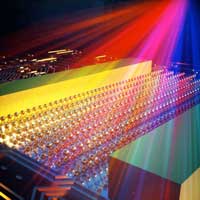 Physicists have managed to achieve ultrastrong coupling between light and matter at room temperature. The discovery is of importance for fundamental research and might pave the way for advances within, for example, light sources, nanomachinery, and quantum technology.
Physicists have managed to achieve ultrastrong coupling between light and matter at room temperature. The discovery is of importance for fundamental research and might pave the way for advances within, for example, light sources, nanomachinery, and quantum technology.
Tuesday, September 22, 2020
Controlling ultrastrong light-matter coupling at room temperature
 Physicists have managed to achieve ultrastrong coupling between light and matter at room temperature. The discovery is of importance for fundamental research and might pave the way for advances within, for example, light sources, nanomachinery, and quantum technology.
Physicists have managed to achieve ultrastrong coupling between light and matter at room temperature. The discovery is of importance for fundamental research and might pave the way for advances within, for example, light sources, nanomachinery, and quantum technology.
Scientists get soft on 3D nanoprinting
 New method could jump-start creation of tiny medical devices for the body.
New method could jump-start creation of tiny medical devices for the body.
Physicists develop printable organic transistors
 Scientists have come a step closer to the vision of a broad application of flexible, printable electronics. They succeeded for the first time in developing powerful vertical organic transistors with two independent control electrodes.
Scientists have come a step closer to the vision of a broad application of flexible, printable electronics. They succeeded for the first time in developing powerful vertical organic transistors with two independent control electrodes.
Hyperbolic metamaterials exhibit 2T physics
 3D nonlinear ferro-fluid-based hyperbolic metamaterials may contribute to ultra-fast all-optical hyper-computing.
3D nonlinear ferro-fluid-based hyperbolic metamaterials may contribute to ultra-fast all-optical hyper-computing.
The world's first photodetector that can see all shades of light
 Researchers have developed the world's first photodetector that can see all shades of light, in a prototype device that radically shrinks one of the most fundamental elements of modern technology.
Researchers have developed the world's first photodetector that can see all shades of light, in a prototype device that radically shrinks one of the most fundamental elements of modern technology.
An acoustically actuated microscopic implant device
 Researchers have developed remote-controlled, mechanical microdevices that, when inserted into human tissue, can manipulate the fluid that surrounds them, collect cells or release drugs. This breakthrough offers numerous potential applications in the biomedical field, from diagnostics to therapy.
Researchers have developed remote-controlled, mechanical microdevices that, when inserted into human tissue, can manipulate the fluid that surrounds them, collect cells or release drugs. This breakthrough offers numerous potential applications in the biomedical field, from diagnostics to therapy.
Parylene photonics enable future optical biointerfaces
 Researchers have invented an optical platform that will likely become the new standard in optical biointerfaces.
Researchers have invented an optical platform that will likely become the new standard in optical biointerfaces.
Subscribe to:
Comments (Atom)
